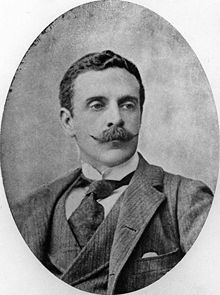- Charles Cochrane-Baillie, 2nd Baron Lamington
-

The Right Honourable
The Lord Lamington
GCMG, GCIE

Governor of Queensland In office
9 April 1896 – 19 December 1901Monarch Victoria
Edward VIIPreceded by Sir Henry Wylie Norman Succeeded by Sir Herbert Chermside Governor of Bombay In office
12 December 1903 – 27 July 1907Monarch Edward VII Governor General The Lord Curzon of Kedleston
The Earl of MintoPreceded by The Lord Northcote Succeeded by The Lord Willingdon Personal details Born 29 July 1860
London, England, UKDied 16 September 1940 (aged 80)
Lanarkshire, Scotland, UKPolitical party Conservative Alma mater Eton College
Christ Church, OxfordCharles Wallace Alexander Napier Cochrane-Baillie, 2nd Baron Lamington, GCMG, GCIE (29 July 1860 – 16 September 1940) was a British politician and colonial administrator who was Governor of Queensland from 1896 to 1901, and Governor of Bombay from 1903 to 1907.
Contents
Early life
Born in London, England, he was the only son of Alexander Baillie-Cochrane, the 1st Baron Lamington. Charles was educated at Eton College and Christ Church, Oxford where he graduated with a Bachelor of Arts in 1883. In 1885, he became assistant private secretary to the Prime Minister of the United Kingdom, Lord Salisbury.[1]
Political career
Cochrane-Baillie was narrowly defeated in the 1885 election for the borough constituency of St Pancras North, but he won the subsequent election in July 1886, taking his seat in the British House of Commons for the Conservative Party.[1]
Upon the death of his father in 1890, he succeeded as the 2nd Baron Lamington.
On 13 June 1895, he married Mary Houghton Hozier at St Michael's Church, Pimlico; they had two children, a son and a daughter.
In 1890, the British Government sent Lord Lamington to travel between Tonkin in Vietnam and Siam, with a view to annexing the Sipsongpanna region of China in an attempt to limit French colonisation of the area.[2]
Governorships
In October 1895, Lord Lamington was selected to replace Sir Henry Norman as Governor of Queensland, and he was sworn in on 9 April 1896. He was a very politically conservative governor, and expressed a concern that the Federation of Australia which took place during his tenure would lead to unrestrained socialism. He also worked with the first Premier of Queensland, Sir Samuel Griffith, to ensure that the role of vice-regal governors was not diminished after Federation.[1]
Apart from six months leave in England when he was knighted GCMG, Lord Lamington served as governor for five years until 19 December 1901. In 1903 he was made GCIE, and appointed as Governor of Bombay, where the royal prerogative he exercised was far more powerful than it had been in Australia.[1]. He is also noted as being sympathetic, after having met ‘Abdu’l-Bahá, to the Bahá'í Faith.[3]
Later life
In 1919, Lord Lamington served as commissioner of the British Relief Unit in Syria, prior to its allocation as a French mandate.[1]
He returned to his family home, Lamington House, in Lanarkshire, Scotland, where he died on 16 September 1940, aged 80.
Legacy
Lord Lamington is best known in Australia for allegedly giving his name to the lamington, a popular Australian cake consisting of a cube of sponge cake dipped in chocolate icing and sprinkled with desiccated coconut. The stories of the creation of the lamington vary widely, although in most versions Lamington's chef Armand Gallan at Queensland's Government House devises the cake either by accident or due to a shortage of ingredients. Lamington is also reported to have referred to the cakes as "those bloody poofy woolly biscuits".[4]
The Lamington Plateau and National Park in Queensland, Lamington Bridge in Maryborough, Queensland, Mount Lamington (a volcano in Papua New Guinea), and Lamington Road in Mumbai were also named after him.
References
- ^ a b c d e R. B. Joyce, 'Lamington, second Baron (1860 - 1940)', Australian Dictionary of Biography, Volume 9, Melbourne University Press, 1983, pp 653-654.
- ^ Lord Lamington in Sipsongpanna (1891), Yunnan Explorer.
- ^ David Merrick (2011). "Abdu'l-Baha in the UK, 1913 (Sohrab's Diary)". p. 25 Dec 1912. http://www.paintdrawer.co.uk/david/misc/sohrab-diary-uk-1913.pdf.
- ^ Shrimpton, James (6 October 2007). "Australia: The tale of Baron Lamington and an improvised cake". The New Zealand Herald. http://www.nzherald.co.nz/section/7/story.cfm?c_id=7&objectid=10467101. Retrieved 23 September 2011.
External links
Parliament of the United Kingdom Preceded by
Thomas Henry BoltonMember of Parliament for St Pancras North
1886–1890Succeeded by
Thomas Henry BoltonGovernment offices Preceded by
Sir Henry NormanGovernor of Queensland
1896–1901Succeeded by
Sir Herbert ChermsidePreceded by
The Lord NorthcoteGovernor of Bombay
1903–1907Succeeded by
Sir George ClarkePeerage of the United Kingdom Preceded by
Alexander Baillie-CochraneBaron Lamington
1890–1940Succeeded by
Victor Cochrane-BaillieGovernors of Queensland 
 Categories:
Categories:- 1860 births
- 1940 deaths
- Old Etonians
- Alumni of Christ Church, Oxford
- Members of the United Kingdom Parliament for English constituencies
- UK MPs 1886–1892
- Barons in the Peerage of the United Kingdom
- Conservative Party (UK) MPs
- Conservative Party (UK) peers
- Governors of Queensland
- Governors of Bombay
- Knights Grand Cross of the Order of St Michael and St George
- Knights Grand Commander of the Order of the Indian Empire
- Deputy Lieutenants of Glasgow
Wikimedia Foundation. 2010.
